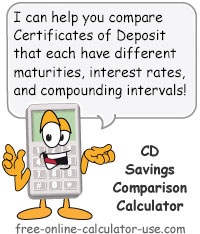IMPORTANT: Numeric entry fields must not contain dollar signs, percent signs, commas, spaces, etc. (only digits 0-9 and decimal points are allowed).
Click the Terms tab above for a more detailed description of each entry.
Step #1:
For each CD you would like to compare, enter the amount, interest rate, and the number of months, and select the number of compoundings per year.
Step #2:
Tap the "Calculate CD Comparison" button and scroll down to view the results, which will include a button for opening a printer-friendly report.


Follow me on any of the social media sites below and be among the first to get a sneak peek at the newest and coolest calculators that are being added or updated each month.